Elizabeth Harrin's Blog, page 27
April 5, 2023
Storytelling – a key competence for project managers?
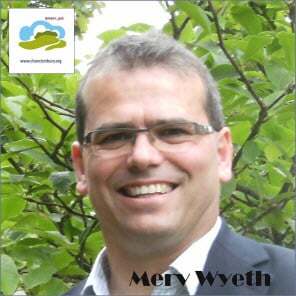
Imagine my delight at being selected to participate in an invitation-only event about management methods. However, a condition of entry is that each participant is expected to address their colleagues using a twenty minute TED talk format, which seems to be the rite of passage in certain quarters.
The actual TED talk principles are refreshingly simple and make me think of those that accompany the Agile Manifesto like, ‘Simplicity – the art of maximizing the work not done – is essential.’
The TED principles are written as modern day commandments, and include ‘Thou shalt tell a story, remember all the while laughter is good and be vulnerable, speaking of thy failure as well as success.’
A lesson in storytellingRecently I attended an APM event with . He spoke about successful project management through telling stories – sticky ones at that.
Throughout the evening Stephen demonstrated his storytelling prowess and explained how the skill is a key part of project leadership.
He explained that sometimes you really do need to be that little bit theatrical to win hearts and minds. Instead of the usual dry, trite phraseology and business vocabulary trotted out at business reviews and Board meetings, we should learn from others how we can use a compelling narrative to build commitment and paint a picture of the future.
Stephen used pictures and memorable video clips to drive his various points home. In his opinion a good project has some striking similarities to a good story. It:
has charactersengages ‘the mind’s eye’takes people on an emotional journeyhas structuremakes an impactembraces complexitycreates meaning – often multiple meaningsdoes not tell – it showscatalyses changeis remembered.Henry Ford, the American Industrialist and inventor said, ‘Whether you think you can or whether you think you can’t, you’re right,’ and with that in mind Stephen is very keen that we should practice telling our own project stories.
Image is PowerfulPart of storytelling is projecting the right image of you, your project and your message – one that sticks, and one that people will remember. Cameron Russell did this when she gave one of my favourite TED Talks to date: Looks aren’t everything. Believe me, I’m a model. She makes an outfit change on stage which is designed to transform the audience perception of her in 10 seconds flat before telling her story, warts and all.
If image is powerful, when coupled with social media it is dynamite – she says that if some of the audience were horrified when she first appeared on stage that she would find out later on Twitter.
I applaud the way she plays down becoming a model as winning a genetic lottery and receiving the legacy of how beauty has been defined in the modern world. She discloses, apparently for the first time on camera, that she is insecure.
Her concluding remark – the story’s message – is that she hopes we will all feel more comfortable acknowledging our perceived successes and our perceived failures.
It’s a story that stuck with me and a good example of how to get your message across in a powerful way.
Stuart & Frank’s G.Y.M.Another event I attended in the same week as seeing Stephen speak was a motivational masterclass with Paul Browning, organized by APM’s ProgM SIG.
I saw another example of powerful storytelling in action. Paul uses the lives of Stuart and Frank, who represent success and failure, and their relationship with the G.Y.M. (Grown your mind) to demonstrate how, in any business or profession, it is the dynamic goal-achievers who consistently succeed.
He described the life and works of Adolf Guyer-Zeller, a Swiss entrepreneur, who was able to inspire others with his audacious idea to build a railway track via a long tunnel through two mountains to the summit of the Jungfrau.
Testament his leadership was that others were sufficiently motivated to see his work through to completion long after he died (1899). The railway to the top of Europe was completed in 1912 – nine years later than originally planned, so not a project that hit its delivery date, but one that was inspired by the power of story.
What story are you telling about your project? Do you even think storytelling is something that project managers should consider? Let us know in the comments.
A version of this article first appeared in 2015.
This article first appeared at Rebel's Guide to Project Management
How I passed the Google Project Management Certificate in a Week
Are you looking for tips on how to pass the Google Project Management Certificate? I completed the 6 courses in a week (what a week that was!).
I don’t remember the last time I was so stressed as I was working full-time at the same time, but I did it, and you can too.
In this article, I’ll share my top tips for working out the answers to the graded quizzes, how to plan your time and how to get the certificate for the lowest possible cost (not free, but very cheap).
 Yey! I made it to the end of the certificate and earned the badge.My experience with the Google Project Management Professional Certificate
Yey! I made it to the end of the certificate and earned the badge.My experience with the Google Project Management Professional CertificateI completed the course requirements in a week. I signed up for the Foundations course and completed that on Day 1, and then on Day 7 I had all the peer reviews back for the Capstone and got confirmation that I had passed the certificate.
The week was incredibly busy and I didn’t do much else aside from work through the course materials and complete assignments (outside of the hours I was actually doing my day job).
Recommended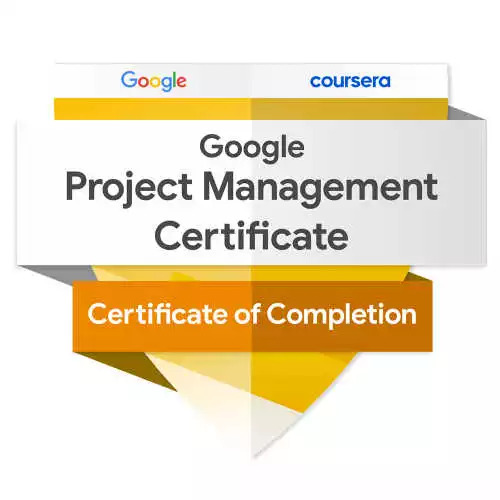 Google Project Management Certificate 5.0
Google Project Management Certificate 5.0 A solid, professional, well-recognized project management course from a great training provider. Perfect for beginners and people interested in learning more about project management as a career.
Learn more Read my review We earn a commission if you click this link and make a purchase, at no additional cost to you #ad How I did it so quicklyI have 20+ years experience in project management, so I am definitely not a beginner. The Foundations module, for example, was really easy for me, and I whizzed through that. The more experience you have working in a project environment, the easier it will be for you.
The less experience you have, the more time you’ll have to spend as all the concepts will be new to you. I spent most time on the Agile module (because I’m not an Agile PM) and the Capstone (because you HAVE to do all the work on that one). The courses on Project Execution and Project Initiation were straightforward for me as that’s my day job.
I worked on all the courses at the same time, pretty much, after I completed the Foundations.
If you have some experience…
If you have project management experience, don’t watch the videos. Scan the transcript instead. Skip any topics you know well and go straight for the quiz. If you pass the quiz, assume you have enough knowledge to miss that topic and save yourself time.
How I did it so cheaplyCoursera works on a subscription model for the Google Project Management certificate, so you have to sign up to take the courses. However, you can audit these courses for free.
First, I signed up to audit the courses. Then I had a good look around the course materials for free. You can watch the videos, review the readings and download the templates without paying anything.
That gave me a good indication that I wouldn’t have to spend the recommended 6 months on the course, and that I could indeed do it quickly (and therefore cheaply).
You only have to sign up as a student and start paying when you commit to earning the certificate for real, as you have to be subscribed to be able to submit graded assignments and quizzes, and peer-reviewed assignments.
Pro tips to save money
Sign up to audit the course first, and then convert to a paid student when you are sure you have the time to commit to doing the assessed work.
If you are offered a free trial, you can also take that and do as much of the course as possible in the free trial period.
So what did I learn from the experience? And what tips do I have for you if you want to earn the certificate as cheaply and quickly as possible? Read on…
1. Make a trackerThere are 6 courses to do in the Google certificate. The easiest is the Foundation, which has no peer-reviewed assignments. The hardest is (unsurprisingly) the Capstone. Each course has multiple modules.
Because of the speed I was going through the materials, I needed a tracker. I just wrote out a list of the courses and modules and made a note of what still needed to be done on them. It kept me focused on what was missing, what assignments I needed to submit (or resubmit) and made it easy to go straight to what needed doing when I had a spare moment.
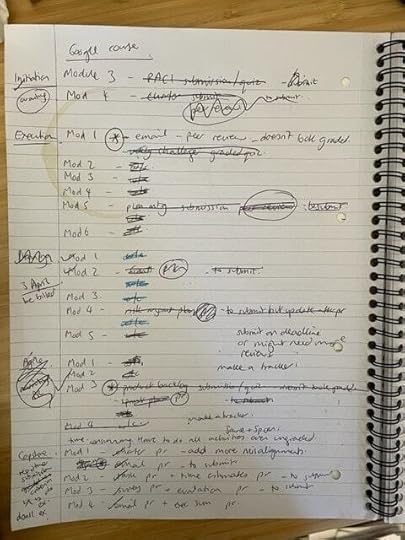 This is my course tracker, complete with tea stain.2. Submit on or before the deadline
This is my course tracker, complete with tea stain.2. Submit on or before the deadlineEach assignment and graded quiz comes with a deadline.
The deadlines are auto-calculated by the looks of it, from the Coursera platform. I first thought they were there simply to help you pace yourself and make sure you didn’t give up on the material.
However, there is some small print I read that said if you submit a peer-reviewed assignment after the deadline you might need more than one peer to review it. If you submit on the deadline, you only need one reviewer.
Don’t wait for extra reviews: submit on time so you aren’t reliant on other people.
3. Note your correct answers on quizzesYou might fail a quiz (I certainly did) but that doesn’t mean you got all the questions wrong. Some quizzes keep the same set of questions when you do them again, so note down the answers you did get right.
Also note down which answers were wrong. The tests are all multiple choice so you don’t want to select the wrong answer again.
When you take the quiz again, use your notes to make sure you don’t accidentally get an answer wrong again, and put in the correct answers.
4. Use the searchTimed quizzes can be stressful, but you get 50ish minutes per quiz which is a lot of time to answer 10 questions.
If you can’t work out an answer, use the search feature. Copy/paste one of the answer responses or a key word from the question into the search bar. Use a new window or tab, not the one your test is open in.
Then review the search results. You’ll often find that the answer to the question is in the course material (I mean, why wouldn’t it be??). Then you can confidently choose the right answer.
5. Watch the videos on 1.5x speedWatch the videos on fast speed. As long as you can still understand the tutors, you’ll be fine. This will help you get through the material more quickly.
6. Do the courses in any orderDo you have to take the Google Project Management certificate courses in order? No, absolutely not. I would suggest you leave the Capstone until the end, but any of the others you can do in any order.
I did them all pretty much in parallel, leaving the Capstone until last.
7. Don’t review the job seeking content unless you are job seekingI know this is going to sound obvious, but if you aren’t currently looking for a job, skip all the sections on job hunting, interview prep and resumes/CVs.
You can also skip the Googlers telling stories about their career paths. They are interesting, but they aren’t crucial to being able to apply the knowledge. If you have loads of time, by all means watch them, but if you are speeding through the content, you can skip them comfortably.
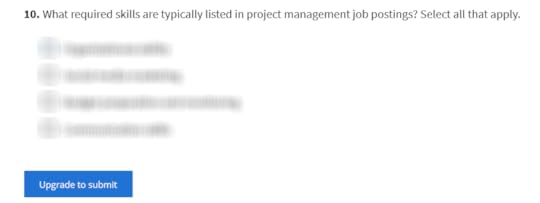 If you audit the class, you’ll see this button, asking you to upgrade to submit your assignment so you can get a grade. Most tests require 80% or more to pass. Tips for the Google Project Management peer-reviewed assignments
If you audit the class, you’ll see this button, asking you to upgrade to submit your assignment so you can get a grade. Most tests require 80% or more to pass. Tips for the Google Project Management peer-reviewed assignmentsMost of the courses have peer-graded assignments. For example, you have to complete a project charter, a risk document, a presentation to executives, write sample emails etc.
The example project is Plant Pals (the Capstone project is Sauce & Spoon), and actually it’s quite fun to work through creating project documents. The case study is realistic and well-put together, you will definitely find it useful if you have not worked on a project end-to-end before.
Here are some tips for acing your peer-reviewed assignments.
1. Make sure your file is publicly accessibleYou have to review other people’s work as well as submit your own, and overall, the quality of the files submitted was poor. There were quite a few that I couldn’t even access because the Google Docs permission was not set to ‘Sharing’.
Make sure people can access your file!
2. Load the right fileYou are given student documents to review, and there were several I was given where I had to flag that they had loaded the wrong file. One was even a promo leaflet for some guy’s training courses. Some people loaded the blank template.
Don’t waste your time (or other people’s) by loading the wrong documents. Come up with a naming convention for all the files you will create and then upload the correct version.
I made this mistake once myself. There are two exercises where you have to write emails and I uploaded the wrong email file for an assignment. Believe me, when people score your assignment as 0/10 and you fail, it really stings!
3. Read the submission criteriaEach peer-reviewed assignment where you have submit a file has two tabs. One tab is your instructions, the next is the upload screen where you share your file so it can be reviewed.
On the upload screen you will see submission criteria. This is basically a list of what the reviewer will be looking for.
Read this before you spend time creating your file so you know exactly how you will be graded and what you need to include in the project documentation.
4. Remember to review other people’s assignmentsYou won’t be marked as ‘complete’ unless you have reviewed other people’s assignments as well as submitted your own and had that reviewed.
It doesn’t take long to look over someone else’s document, especially as you have just written one on exactly the same template. You will be given a marking scheme so you know exactly how to assign marks.
Put some time aside as soon as you have submitted your assignment and just get through them. You’ll know when you have done enough as it will invite you to review more, but you are not obligated to.
5. Keep them shortIt’s tempting to write loads and loads in the project charter or other documents, but you really don’t have to. Stick with a few bullet points that cover the key content.
In real life you might want to add more context and more words, but generally short is good. There are only certain things that will be graded anyway, so any text you put in additional boxes is not going to score you extra.
That’s not to say you shouldn’t do a good job, especially if you are hoping to get the practice of putting together project documentation – useful if you want to become a project manager. But if you want to get through the course fast, do the minimum required and don’t gold plate your assignments.
Tips for the Google Project Management Capstone ProjectThe Capstone course (Applying Project Management in the Real World) is the Sauce & Spoon case study, which is a fun project about rolling out a new system for a group of restaurants. It feels timely and relevant, with a cast of characters you’ll come to feel like you know.
You are the project manager, and the goal is to shepherd the project through from idea to delivery – which of course you manage to do just fine.
Here are some examples of the Google Project Management Capstone assignments:
Create a project charterDraft emailsIdentify project tasks and put them in order with milestonesIdentify and create time estimates for a project planIdentify quality criteria and establish how these will be measuredCreate a presentation to share project resultsDraft an executive summaryThe Capstone also includes a section on preparing for an interview, which you don’t have to do.
Here are some tips to stay on top of the Capstone.
1. Pace yourselfIt was a lot more work than I was expecting. There are 8 peer reviewed assignments which equals 8 documents to create, submit, and then review someone else’s submission.
Given that I am an experienced project manager who had breezed through the other content, I figured I would also find it easy.
It wasn’t hard (for me), but you can’t skip sections. It is time-consuming so make sure you have time put aside.
2. Do the ungraded assignmentsI thought I would save myself time and skip the assignments that are ungraded, focusing instead on the peer-graded projects instead.
I quickly found that you can’t do that. You open a peer-reviewed assignment brief and it says, “Take the project charter you created earlier…” and if you haven’t created one earlier you have to go back and do it from scratch.
You need to work through all the activities, even the ungraded ones. There is important case study information and ground work that you cannot skip.
3. Don’t stress about people being available to reviewI was really worried that no one would be online or available to review my assignments. What if no one else was studying at that time? What if I was the only one in the whole world completing the Capstone and I’d have to wait for someone new to enroll so they could mark my work?
All those worries were completely unfounded. There are plenty of people going through the same experience. I was reviewing papers uploaded just that day, and people were reviewing mine within hours.
The longest I had to wait was about 18 hours. I went to bed worried no one would see my paper and in the morning it had been graded.
4. Look for the Capstone answersAll the answers are in the case study. You don’t have to make anything up (although you can embellish if you want). Just read the materials carefully and write down what you learn.
You don’t even have to infer or deduce. I think every answer and expectation is there in black and white on the screen. For example, success criteria and KPIs, they are written in the case study materials.
I’ve never had a project meeting in real life where a sponsor has said, “We’re looking to improve turnaround time by 5% and reduce customer waiting time by 30 minutes.” But the Sauce & Spoon stakeholders are very switched on and articulate! In real life, expect to have to gently coax senior managers to come up with numbers they can be held accountable to!
5. Do the workI wonder how many people start the 6 certificate courses and then get to the Capstone and think, “Whoa, that’s a lot of work.” And then drop out.
Don’t let that be you. You can do it. There is no time limit on taking the course, and if you show up and do the work, you will pass.
The Capstone is a lot more work than any of the other courses. I think there are only 5 peer-reviewed assignments in the whole of the rest of the course, and while that gets you used to the process and the expectation, the Capstone takes it to a whole new level.
That’s the point, after all. They want you to feel confident and to ‘see’ a project from start to finish.
Before you go…You can definitely pass the Google Project Management Certificate, I have no doubt. There are no tutor-assessed assignments. You can take the graded quizzes as many times as you like (within the system constraints) and if you plod through the work, you can do it!
You earn a Credly badge at the end of it, which makes it all worthwhile.
I did have a stressful week, so I wouldn’t recommend doing what I did and cramming the course, but I do think the course was good and worthwhile. Read my full review of the Google Project Management Certificate.
If you have read this because you are considering signing up, I’d recommend it. If you’ve got to the end of the article because you’re halfway through the course and need the motivation to keep going… keep going!! You’ve got this ?
Recommended Google Project Management Certificate 5.0
Google Project Management Certificate 5.0 A solid, professional, well-recognized project management course from a great training provider. Perfect for beginners and people interested in learning more about project management as a career.
See the course Read my training review We earn a commission if you click this link and make a purchase, at no additional cost to you #adThis article first appeared at Rebel's Guide to Project Management
April 3, 2023
How to Get a Job as a Digital Project Manager
 Holly Davis, Digital Project Manager for White October
Holly Davis, Digital Project Manager for White OctoberAt the Digital PM Summit in Philadelphia, a conference full of digital project managers (DPMs), it was interesting to hear about the various ways DPMs have found their way into a career in project management.
Listening to some of the panels, talks and in conversations with the DPM community, I heard that many, like me, have fallen into the career by accident.
It’s often because they have gained the transferable skills found in most good PMs, the combination of soft skills, organization and a natural aptitude to get things done.
But the profession is growing up and new entry paths are emerging. The most exciting of these being the emergence of apprenticeship and the rise in internships and work experience placements both in the UK and US.
Scrum Certifications are also increasingly in demand as agencies begin to explore a hybrid of agile and waterfall methodologies.
Dave Prior, agile consultant for Leading Agile ran an agile retrospective at the Summit with 100 attendees, 63% of which claimed to be practicing both scrum and waterfall in the same organization.
As was clear from the Philadelphia Summit, what works for one person or agency might not work for another.
Post-conference I caught up with some DPMs and agencies to see what they had to say.
1. Consider getting certifiedCertifications can open doors, according to Carson Pierce, PMP and CSM Certified and works at DDB.
“Can you be a PM without a PMP? Of course. Most people do. Will you be a better PM with it? Of course – all knowledge is valuable.
A lot of people poo-poo the PMP certification, but it’s been huge for me. I understand the concepts behind the things we do and the software we use. If I talk to someone in a different field, we can talk the same language.
And those three little letters have gotten me a lot of respect from clients, which is really helpful in building trust quickly.”
Another certification to consider is the Google Project Management certificate, which is an entry-level alternative if you don’t meet the eligibility criteria for PMI’s Project Management Professional exam.
Recommended Google Project Management Certificate 5.0
Google Project Management Certificate 5.0 A solid, professional, well-recognized project management course from a great training provider. Perfect for beginners and people interested in learning more about project management as a career.
Learn more We earn a commission if you click this link and make a purchase, at no additional cost to you #ad 2. Learn the skills on the jobMel Wilson, Project Manager at Incuna had the following to say.
“After graduating from university, I decided to pursue a career in project management. Unfortunately, the majority of vacancies were looking for at least 1-2 years experience which I didn’t have.
I therefore decided to interview for a support admin position at White October – one of the leading agencies in Oxford. Although this wasn’t exactly the job I wanted to be in eventually, it provided me with great exposure to the workings of an agency and all of its functions.
Within a year, I had learnt the basics of project management and was able to quickly prove myself as a DPM. The support admin was just a stepping stone for me, 18 months on I’m now where I want to be. I’d recommend this route to others.”
3. Dip your toe in the water with an apprenticeship or internshipAnna Lewis, Senior Recruiter, Viget
“We recognize that certifications in certain industries and environments can be useful, but they don’t usually prepare someone for a career at Viget.
They don’t prepare people for what PMs actually do day-to-day in our agency setting. We’re looking for individuals who are smart, detail-oriented, unflappable problem solvers — certifications can’t tell us whether someone has those skills and qualities the way we think a 10 or 12-week apprenticeship scheme can.
Most applicants for our apprenticeship have no previous experience of project management. When we embark on an apprenticeship with an individual, there are questions for both Viget as a company and for the apprentice: will they be a good fit, will they actually like the job, what are their strengths.
For Viget, an apprenticeship seems to be a great way to start answering those questions.
At the end of the apprenticeship, if an apprentice has developed an informed perspective on what it’s like to work in our industry, what the project management job requires, and whether it’s right for them, then we think that’s really positive and valuable.”
If you can’t find a scheme like this where you live, contact an agency you aspire to work for and ask if they’d be interested in doing something like this at a smaller scale.
Shadow days where you shadow a project manager for a day a week can be an incredibly useful introduction to a career in project management.
Parting wordsThe face of the profession is continually evolving. This time next year there will be new standards, processes, tools and with that new opportunities for people wanting to pursue a career in project management
As you can see, the options are vast, so if you’re feeling overwhelmed, start with doing some research. Think about the type of projects and companies you might like to work for.
The way companies manage projects can vary massively, do your homework, find out what they look for in a potential employee and then map out which of the options outlined above might help you get there!
A version of this article first appeared in 2015.
This article first appeared at Rebel's Guide to Project Management
April 2, 2023
Free and Low Cost Project Management Resources

There was a question in our Facebook group recently: where can I get project management templates? And another question: where can I get free or cheap project management training materials?
There are many premium project management templates available — including my template bundles and ebooks. And training to choose from.
But I understand that not everyone has the finances to buy templates or invest in training. Personally, I’d like to think that your PMO will purchase the templates that you need to use, or that your manager will let you buy templates on their corporate credit card.
And that they will support your career development by funding your training.
However, if that isn’t the case, you’ll be looking for free project management templates and training you can use as part of a discussion with your leadership team about why they should really be investing in resources that help you deliver change more effectively!
So here are some places to find free project management templates and other resources. I’ve also included some low cost/high value resources that I find myself recommending frequently to people who are on tight budgets.
Free project management templatesProjectmanagement.com has a huge free library of free project management templates. They also have premium templates which you can get free if you are a PMI member. I find their search engine quite difficult to navigate but if you spend the time hunting you can normally find the document you want.
And my free project management templates are here.
Free project management trainingWhether you are looking to take an exam in project management, boost your skills in a particular area, or earn some Professional Development Units to demonstrate your continuous professional development, there’s a course that will help you.
However, some of them are fiendishly expensive. Or simply not very good.
Over the years I have reviewed, used and tested dozens of training courses and study materials, so you don’t have to take any chances.
Here are some free and low cost/high value project management training resources available online that I find myself recommending frequently to people who are on tight budgets. Despite some of these not costing anything, some of these links are affiliate links which means I’d make a small commission if you spent any money on them.
These are all products I’ve tried out myself and can personally recommend.
PMI KickoffKickoff from PMI® is an excellent free beginners project management course that comes in Agile and Predictive versions. Perfect for accidental project managers and people needing a structured approach to project work for the first time.
Plus you get a Credly badge to display on your LinkedIn profile.
Best for: People who need a quick overview in a couple of hours.
Free training! Kickoff from PMIAn excellent free beginners project management course that comes in Agile and Predictive versions. Perfect for accidental project managers and people needing a structured approach to project work for the first time.
 Take the course We may earn a referral fee if you sign up #pmiaffiliate #ad Google Project Management Certificate
Take the course We may earn a referral fee if you sign up #pmiaffiliate #ad Google Project Management CertificateOK, this one is only free if you don’t want to take the peer-reviewed assignments and graded tests. If you want a comprehensive overview of project management, you can audit the course and work through the material for free.
You will have to upgrade to a paid option to get access to the graded materials, but in my experience you can complete the course in a month if you dedicate enough time to it.
So…. free for learning (choose to audit the courses) but not free to get the Credly badge for your LinkedIn profile. You can’t say you’ve ‘earned’ the certificate if you have only audited the courses, but you will come away from it knowing loads about project management.
Best for: People who need a comprehensive project management class.
Recommended Google Project Management Certificate 5.0
Google Project Management Certificate 5.0 A solid, professional, well-recognized project management course from a great training provider. Perfect for beginners and people interested in learning more about project management as a career.
Learn more We earn a commission if you click this link and make a purchase, at no additional cost to you #ad OnlinePM CoursesDr. Mike Clayton offers well-respected project management training and his free 78-minute video course, PM Fundamentals, is good for beginners.
BrainBOK ITTO ExplorerDid you know that Enterprise Environmental Factors is an input to 27 PMBOK® processes? Nope, neither did I. BrainBOK has an ITTO Explorer makes all of that transparent. You get limited access to it for free, plus a 200-question sample exam paper to help you prepare for the PMP® exam.
There are paid plans also available if you want more.
Free project management exam simulatorsIt’s widely acknowledged that if you want to do well on exams, having the chance to practice in a realistic environment is important. Enter the exam simulator. You can get 7 days of free access to a number of exam simulators, so you can test out your skills before taking the real exam.
Free CAPM® exam simulator – 7-day access
Free PMP® exam simulator – 7-day access
Free PMI-ACP® exam simulator – 7-day access
After the 7 day period, you will need to pay to upgrade your access if you want to use the tools for longer.
PMP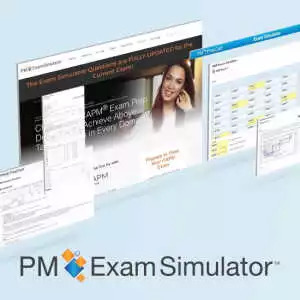 Our Pick
Our Pick 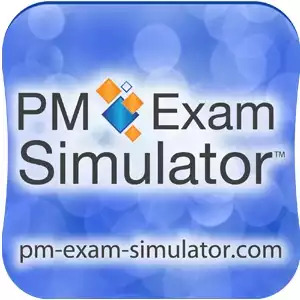 PMI-ACP
PMI-ACP  The PM PrepCast PMP Exam Simulator The PrepCast CAPM Exam Simulator
The PM PrepCast PMP Exam Simulator The PrepCast CAPM Exam Simulator PMI-ACP Exam Simulator 4.8 4.0 4.0 Learn more Learn more Learn more PMP
PMI-ACP Exam Simulator 4.8 4.0 4.0 Learn more Learn more Learn more PMP  The PM PrepCast PMP Exam Simulator 4.8 Learn more Our Pick
The PM PrepCast PMP Exam Simulator 4.8 Learn more Our Pick  The PrepCast CAPM Exam Simulator
The PrepCast CAPM Exam Simulator 4.0 Learn more PMI-ACP
4.0 Learn more PMI-ACP  PMI-ACP Exam Simulator 4.0 Learn more Free resources to earn PDUs
PMI-ACP Exam Simulator 4.0 Learn more Free resources to earn PDUsWatch my past webinars for free. Each one will earn you a PDU or more, and I promise you’ll learn something at the same time!
Cornelius Fichtner offers a free podcast that you can use to claim PDUs – good if you are trying to develop your skills or get your PDUs sorted for the year. He also offers a free taster of his PMP training.
If you hold the PMI-ACP certification, you could use the free Agile PrepCast lessons to earn a few PDUs towards maintaining your certificate.
Free eBooksMany software vendors have free ebooks full of useful advice like this one, this one, and these.
You do have to expect a sales pitch or a mention of their product, but the fundamental guidance on project management is good and often better than you’d get through random Google surfing.
Low cost resourcesThere are dozens of places to go online to learn more about project management. Most of the options above have paid-for products as well, if you want to dive deeper and like the teaching style or resources offered.
Coursera has a lot of options, but you’ll have to pay to access the materials beyond the trial and you’ll need to choose carefully to make sure the course you choose is going to meet your needs.
I looked at one MOOC on time management for project managers (yes! I definitely need this) and found the syllabus was all schedule management techniques (no! I don’t want to learn about crashing, thanks anyway). The description wasn’t misleading, but I misinterpreted it.
From time to time, Udemy runs a really great discount deal on their courses and there are quite a few highly reviewed project management courses there.
One area I get asked about a lot is work breakdown structures. WBSCoach is a good tool to improve your skills in that area.
I have premium templates too, that are actually more than just templates as you get guidance on how to use them too like this meetings template kit and this stakeholder template kit.
PMP® Training & Study GuidesPM PrepCast: Video training course from Cornelius Fichtner. Provides the 35 contact hours you need for the exam and all the relevant material. (The CAPM® version is here – this certification is perfect for project managers just starting out or without the relevant experience to qualify for the PMP exam.)
The PMP® Exam Simulator: I can’t tell you how important it is to practise under exam conditions. Taking sample papers without a time limit isn’t enough. I’ve used this realistic simulator and it’s great! (The CAPM® version is here.)
The PM Formulas: I’m sure you can find lots of lists of formulas on the internet for free, but I like this one because it actually explains them and helps you understand why they are used. Comes with 105 sample formula questions.
BrainBOK: Once you’ve exhausted the free content in BrainBOK you’ll want to upgrade. You get 3 practice exams, an exam focusing on formula, flashcards and more. Provides 35 contact hours required for the exam as well.
Brain Sensei: A fun, online video course that works on mobile. A bit more expensive than the other options here, but high quality interactive learning.
Other training Study Materials for PMI CredentialsThe Agile PrepCast: Video training course from Cornelius Fichtner for the PMI-ACP® Exam. Qualifies for 21 Contact Hours to qualify you to take the exam.
PMI-ACP® Exam Simulator: It’s very important to practise for the exam. It’s not enough to know the answers – you have to be able to perform in exam conditions. This exam simulator is so realistic and will help you mentally prepare for the test.
Other Training CoursesWork Breakdown Structures: One area I get asked about a lot is work breakdown structures. WBSCoach is a good tool to improve your skills in that area.
OnlinePMCourses: There’s a full range of reasonably priced training from Dr Mike Clayton. Everything from risk management to a comprehensive course. Priced by month or for lifetime access.
PRINCE2® and PRINCE2 Agile®: Courses from Mplaza Training that will get you through the PRINCE2 family of certifications.
Looking for something else? Check out my past archive of articles and reviews of different training courses.
Pin for later reading:
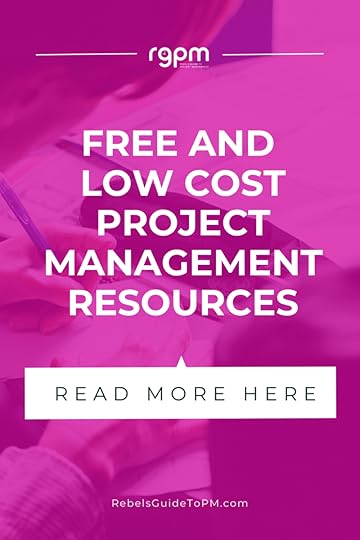
This article first appeared at Rebel's Guide to Project Management
How to Recover A Troubled Program
There’s only one thing worse than being told bad news, and that is being told about bad news late.
When a program is failing, you should define the problem and potential solutions, and alert stakeholders at the first sign of trouble, according to LeRoy Ward, Executive VP at ESI.
His ‘Managing and Saving Programs in a Changing World’ webinar covers 5 steps for project recovery.
Ward started off by explaining what a ‘troubled program’ is. There are several things that can go wrong in program management:
Business case deterioration: the program started off with a good business case but it no longer stacks up.Stakeholder evolution: people change and new leaders at the top change the direction of the program.Technical failure: this creates a program integration risk as what you are building might not sit in the organization’s architecture any longer.Resource collapse: either in the form of strikes or a key resource leaving.Focus on gaining controlDon’t focus on the wrong issue. The wrong issue is how you can catch up and finish on time. The right issue is how do you finish at all and gain something realistic benefit without ending up with a failed project.
You need to regain control. ‘Control’ is the scope, dates and roles on the program which have been lost in through planning or execution in the first place. The way out of this is to make big, targeted changes quickly.
This conflicts with the advice Scott Berkun gives in his book, Making Things Happen. He warns that if you make large changes you push the project off course and it can take a while before you see what you have done.
Then you over-correct by making another big change and you just weave from one crisis to another because you can’t keep your project on course. So be careful about making big changes on a project that isn’t going that far wrong.
Problems facing failing programsWard identified several problems faced by failing programs:
Completing an accurate assessment of program problems is difficult for the program management team because they lack objectivity. Using an outside assessment team creates objectivity. Bring in technical specialists as required.There will be pressure from stakeholders to commit to a new schedule. Measuring progress in small steps will help tremendously.It takes time to determine the work remaining. Data about how far off the original estimates were is needed to make accurate forecasts.You need to sustain progress while planning recovery. Additional temporary resources will be needed to do this. The program manager should direct the current workflow plus do all the work required to make progress with the recovery – no easy task!Ward cautioned against declaring victory too soon. Sustained control is necessary to prove that something has been turned around. It takes teamwork to turn a program around and then keep it moving in the right direction.
If you seeing any of the problems faced by troubled programs then you need a project recovery plan to get back on track.
The five-step project recovery planHere’s the five-step ESI process for getting out of trouble. The whole approach assumes you have been parachuted in to fix someone else’s failing program.
You can adapt the steps if you are trying to turn your own program around, or make the steps smaller to rescue a project instead of a whole program.
Assessment PhaseStep 1: Define CharterDuration: 1-2 days
This formally sanctions the existence of an assessment and project recovery effort. It provides the assessment and recovery lead with the proper authority to complete the activities necessary to develop an assessment plan.
Define the charter with the sponsor and steering committee. The charter should cover:
Program history and sensitivities (although I wouldn’t write all this down)Assessment approach: how many people are you going to interview, in individual meetings or in group sessions and so on.An action plan with dates.Then get it all agreed – which is what the charter is for. In this step you would also initiate contact with the program and project teams.
Step 2: Develop assessment planProduce your plan for assessing what is going on in the troubled program. Aim to allow the assessment team to perform their assessment quickly, ensure accurate findings, and minimize distractions for the project team. After all, you want to keep going with things that are progressing well.
During this time you will:
Establish a teamReview and analyze the assessment model (how are we going to review documents, how are we going to move forward with analysis)Review critical documentsDevelop assessment plan.This is a formal step, so get the recovery plan signed off.
Step 3: Conduct assessment planDuration: 2-5 days
Carry out the activities on your plan. Determine the true current status of the program and constituent projects. Look for major threats, opportunities and problems. You begin to consider the recovery as well as who would be on your recovery team.
The work required at this step includes:
Establishing a war roomAssembling the teamImplementing the assessment plan (interviews and document review)Aggregating and ranking the findings from the most problematic to least problematicValidating, updating and finalizing your findings with the program team and sponsor.Recovery PhaseStep 4: Develop recovery planThis step leads to a plan to get to a functioning program. You establish a road map and process to achieve the goals, and continue to build confidence and morale.
Prepare a plan that everyone sees as realistic and achievable: this helps build confidence. There is no Plan B for this recovery plan: this is it! The goal is to save the program from loss and restore it to usefulness, preventing total failure along the way.
Produce an achievable scheduleRe-establish customer management confidenceNegotiate a new baselineStep 5: Conduct recovery planNow execute your recovery plan to get the program back on track or at least delivering something valuable. This includes validating all the estimates and checking how people arrived at them because it helps you produce an accurate forecast for program completion.
Through all of this what you are trying to do is begin with the end in mind: a program that is no longer in recovery. If you keep that objective at the heart of everything you do you’ll get to a successful conclusion. That might be:
A project or program that is shut downA project or program that is back on trackA project or program that isn’t going to deliver everything the sponsor hoped for but will turn in something of value.Any of those options are OK because the uncertainty has gone.
If you’ve read this far, click through to my definitive guide to project success criteria next. It gives you a breakdown of how to define success which might help you avoid a failing project in the first place.
This article first appeared at Rebel's Guide to Project Management
April 1, 2023
3 Ways to Practice Your Leadership Skills
 Mike Clayton
Mike ClaytonTrue leadership is not something you do when it suits you. In fact, true leadership emerges when it is least convenient, in tough times, under extremes of pressure.
These are the situations that separate out the good project managers from the poor, and the true project leaders from the ‘merely competent’ project managers.
Here are three things we can all practice, day-to-day, to hone our leadership skills:
1. ListeningThis is the master skill of a great communicator and we could all do it a whole lot better than we do, by tuning out our tendency to rush to judgement, and instead, paying attention to what we are hearing.
2. Decision makingDecision time is a splendid opportunity to practice excellent leadership. Will you make the decision yourself and, if you do, how will you communicate it? Or will you involve team members and, if so, to what extent? Decision-making on a project is an act of leadership.
3. Step away from the projectWhilst a familiar phrase of mine to anyone who has attended my project management seminars or workshops is “there’s no such thing as an absentee project manager: it’s a contradiction in terms,” this does not mean you need to be present at all times.
Make time to step away for an hour or so, at least once a week.
This can give others a chance to lead but for me, the prime reason is to clear your head and think about what is around the next bend. If you are not taking the lead and doing this, then nobody else will.
People like to be led and, in the absence of good leadership, they will often just follow the first fool to make a move, just to avoid having to make their own decisions. So, if you are prepared to lead, not only is that commendable, but you will usually be pushing at an open door.
But this does not mean that good leadership is easy. There is so much for a project manager to keep in balance that it sometimes seems as if you will have little or no spare time to lead: but lead you must.
My book, Brilliant Project Leader, identifies the four essentials of team leadership. They are each simple to address: focus on individuals, build and share a clear plan, foster a true sense of team spirit, and communicate relentlessly – and well. Invest time in getting each of these right, and the rest will start to follow.
Each is simple, but simple is not easy. You will need to work at it every day.
But, if you do, the rewards will be massive.
You’ll get the team you deserve and you will deserve the team that you want. This will be a team that works hard for you, for your project and for themselves, to achieve the most astonishing results.
 Differences between leadership and management
Differences between leadership and managementThere are a lot of models of what leadership is and how to develop it: situational leadership models that enjoin us to tailor our approach to the context and the person in front of us, role-based models that suggest we should fulfill the functions most needed of us, and traits models that argue we need to cultivate the personality and character traits that our followers most value. There is a lot to learn from all of these.
But since starting Brilliant Project Leader, I have been reflecting on all of these and how to merge them all, productively.
The book that followed it is Smart to Wise – about how to develop wisdom so that you can take your career and your life to the next stage. And one thing stands out for me when I think about leadership and wisdom. I am going to suggest that the key to both is mindfulness.
There may be instinctual leaders out there who don’t need to think. There may be gifted sages capable of wise insights by virtue of deep instinct. But for most of us, getting leadership right is challenging and you must remain mindful of that challenge at all times. A careless word, a hasty decision or a superficial assessment of one of your team’s deliverables can set your project and your relationships back a day, a week or a month in the blink of an eye.
Be constantly mindful of your responsibilities and of what you are there to do, as project leader. Use your knowledge and experience to help you to think through how to lead, and above all, be there for the people who are looking to you for that leadership.
This article first appeared on the blog in 2013.
This article first appeared at Rebel's Guide to Project Management
March 23, 2023
Fundamentals of Project Planning and Management: UVA Darden Course Review
Recently I audited the Fundamentals of Project Planning and Management course from University of Virginia Darden Business School. It’s one of the most popular project management courses on Coursera.
I’ve put together this Fundamentals of Project Planning and Management course review to answer all your questions so you can save time deciding whether it is right for you.
In the review, I’ll share:
Why I think this is such a popular course for project managersWho it’s most suited forHow to get the most out of the course. How I did this review
How I did this reviewI signed up for a Coursera free account and audited the class. I watched the videos and took the ungraded quizzes, working through the course materials to see what I thought of the content and the course learning management system.
Who is the Fundamentals of Project Planning and Management course for?I think this course is aimed at early-career project professionals who quickly need to upskill in planning, scheduling and project controls.
I would say it is most useful to people who are already working in a project team environment. Especially those working in linear and waterfall environments, as I think it covered those topics really well.
It’s an entry-level course in that the first module is an overview of topics like project goals and what project success means, but it quickly gets into technical topics like tornado charts, Monte Carlo simulation, network analysis and other tools and techniques that allow you to do robust, professional planning.
In other words, if you are finding that the ‘guess how long a task takes’ school of estimating and project planning isn’t working out for you, then this course will quickly help you up your game.
However, this course is going to be most value to project managers who have tools to help them manage their work. The examples shown often use Microsoft Project and Excel, and if you work in an organization that relies on Kanban-based tools then you might not be able to apply the knowledge you’ve learned to your day job.
Do in a day Fundamentals of Project Planning and Management 5.0
Fundamentals of Project Planning and Management 5.0 A great short course from UVA Darden covering the basics at a good level. Best for project managers with some experience who want to improve their planning and project control.
See the course We earn a commission if you click this link and make a purchase, at no additional cost to you #ad How the course is structuredThe course is structured into 4 modules:
Welcome to the World of ProjectsThe Ins and Outs of Project PlanningIt’s a Risky World and Then the Unexpected Happened (this module on project risk was my favorite)Ready, Set, Go: Project ExecutionEach module ends with a quiz that helps consolidate your knowledge.
There are also case study questions that you answer via the discussion prompts. You don’t have to answer these, but why wouldn’t you? It will help you think through how to apply the knowledge in real life.
 Whoop, almost there!The course content
Whoop, almost there!The course contentThe content included in the training will give you a broad overview of what it means to manage a project, from setting objectives, creating a project plan, defining project scope and selecting an appropriate project management methodology.
It sounds like the material is high-level but I honestly didn’t find it that way. It covers cost control, work breakdown structures, schedule risk analysis, cost risk analysis: these are weighty topics.
The course does cover Agile methods, iterative and incremental planning, but again, it’s very high-level light-touch awareness rather than giving you the skills to be able to go away from this training and lead a Scrum team, for example.
How much does it cost?The course is not available on the Coursera Plus plan, which is the monthly subscription that gives you access to a lot of the learning materials on the platform.
If you set up a free account and enrol in the course, it will give you the option to upgrade to take the graded quizzes, and the price it shows me for that is a one-off cost of £48.
How to pass the Fundamentals of Project Planning and Management courseYou have to pass the 4 knowledge quizzes. These are untimed and multiple choice, but difficult!
However, you are able to have the course materials open in another window, so you have got time to check your responses and be confident in your replies. And you can take the tests again if you don’t hit the 80% pass mark.
TipUse the ‘search in course’ feature to quickly find the topics that you are looking for.
You can work out the Fundamentals of Project Planning and Management Coursera quiz answers as you can take the quizzes multiple times. The ungraded quizzes show you the results on the screen as soon as you submit them.
If you get an answer wrong, make a note of the answer you submitted that was wrong, and don’t choose it again next time. Refresh your learning on the topic by re-watching the relevant video or reading the transcript. Work out why the answer was wrong and consider what you would select next time to improve your chances of getting it right.
In some cases, like for the Earned Value quiz, there are only two answers, so if you get the multiple choice question wrong, you know by default what the answer should be for when you attempt the quiz again.
Why this course is popularOK, this is my opinion about why the course is a popular project management choice amongst all the other Coursera options.
It will take you a day to go through the materials. That’s fast, especially in comparison to the Google Project Management Professional Certificate which is more like a 6-month commitment.
If you need a certificate or something to evidence at job interview that you know what you are talking about, this is a quick one to get.
It’s university-level course. That’s clear in the presentation, the detail, the slides, the depth of material. However, it’s a university 101 style content. You may understand the jargon and concepts after going through the Fundamentals training but it is only the fundamentals… clue’s in the name.
I don’t think I could create a tornado chart in Excel if this was my only introduction to tornado charts, for example, but at least if I saw one I’d know what it was, and if I thought it was appropriate to use one I could go away and do more research into how to make that happen.
The same with earned value: project management performance is covered, but I’m not sure that I could apply it to my projects having watched the video and taken the quiz.
All things being equal, this course will show you frameworks for scoping projects and taking them through the execution phase to project completion.
 This module on it being a risky world was my favoriteHow to get the most out of the course
This module on it being a risky world was my favoriteHow to get the most out of the courseThe course is hosted by Coursera, and the platform is really good. To get the most out of the course, use the in-platform features to help you take notes and keep the momentum going.
The transcripts are time-stamped and nicely laid out so you can quickly find what you are looking for.
The search-in-course feature helps you go straight to the content topic you are looking for, and that is a huge time saver for when you want to go back and check where you heard about a topic.
You can also download the videos if you want to study in an area that doesn’t have internet connection.
ProsThe advantages of the Fundamentals course are:
It’s fast to get through and yet in-depth, which is perfect if you want to check out university courses but don’t have time or don’t know whether a project management degree is right for you. It’s fully online so you can fit in study around your daily life.It includes case studies of real, big projects including interviews with real people. For example, HealthCare.gov, Virginia Festival of the Book, Lumi Juice.It’s cost-effective.The trainer, Yael Grushka-Cockayne, Associate Professor at UVA Darden, comes across as a genuine expert, warm and sharing her expertise. She’s obviously taught many students over the years and her command of her materials and tech is great. It doesn’t sound like she’s reading from a teleprompt (unlike the people teaching the Google Project Management Certificate, who very much sound like they are reading off a teleprompter).
Plus, you can audit the course for free. You can’t do the timed quizzes and earn the certificate, but you can certainly upskill and work through the materials for free.
ConsThe disadvantages of the Coursera Fundamentals of Project Planning and Management (that’s such a long name!) training that I found are as follows.
First, it’s not available in the Coursera subscription so you have pay extra for it. Having said that, it’s only showing me the price of £48, which is not a lot if you want to have a university-taught course on your resume before you apply for a job.
You can’t take the quizzes on mobile. The diagrams don’t show up. I don’t know if that is a quirk of not having the paid version of the course, but the diagrams definitely appeared when I viewed the quiz on my laptop.
Without the diagrams, you can’t answer the questions as they rely on you being able to calculate paths through a network diagram… and you can’t do that if you can’t see the diagram.
Finally, there is nothing in the course about soft skills (the ones PMI calls Power Skills). I suppose they are mentioned tangentially, inferred from the way you have to work collaboratively with project management tools and motivate team members, but there isn’t a module on that kind of thing.
If you are looking for something that will equip you to work with stakeholders, then this isn’t it. But it is called Project Planning and Management, so you wouldn’t really expect the training to cover anything except that.
 I watched the videos with the subtitles on… and I didn’t think it would take much to have changed this to ‘he or she’ or even ‘they’ when talking about who is the project manager. Recommendation: Is this course for you?
I watched the videos with the subtitles on… and I didn’t think it would take much to have changed this to ‘he or she’ or even ‘they’ when talking about who is the project manager. Recommendation: Is this course for you?I do recommend this course. I enjoyed the materials, I thought it was well-put together, confidently delivered, and the student feedback is positive.
The material is well-pitched and is at a good level for a fundamentals course, covering a range of tools and methods. It’s also grounded in the real-world, with real case studies, sensible approaches to managing uncertainly and it doesn’t give the impression that you can just apply a few tools and everything will work out well.
If you are looking for a short course that covers the basic key concepts and will give you a wide-ranging understanding of core project management topics, then this is for you.
Ready to check out the course yourself?
Do in a day Fundamentals of Project Planning and Management 5.0
Fundamentals of Project Planning and Management 5.0 A great short course from UVA Darden covering the basics at a good level. Best for project managers with some experience who want to improve their planning and project control.
See the course We earn a commission if you click this link and make a purchase, at no additional cost to you #adI should let you know that I am so impressed with the Coursera platform and the content available on it that I’m now an affiliate for their training, but I only recommend products I have tested out and am confident in.
This article first appeared at Rebel's Guide to Project Management
March 22, 2023
Google Project Management: Professional Certificate Review
Are you ready to dive into my Google Project Management: Professional Certificate review? I’ve done a lot of project management training in my 20+ years as a project manager, and those courses helped me understand the skills, tools and techniques required to succeed leading projects.
Luckily, many of those training programs have been paid for by my company over the years, or provided as internal courses. However, these days companies seem to be paying for less and less corporate training, and I speak to many project managers who are using their own funds to buy training.
But… it’s really important to choose a good course. If you are going to take a professional certificate, you need to be sure that you are spending time (and money) on something that is worth it. And many of the professional bodies offer certificates and credentials that require pre-requisites.
In this Google Project Management: Professional Certificate review for beginners, I’ll share:
Why the Google Project Management certificate doesn’t require pre-requisites (and what you do need to pass)Why it’s especially good for early career project managersHow long you’ll need to spend going through the course materials before you pass, and what that process looks like.This course is one of the most popular project management certifications out there, with thousands of students from around the world. I’ve spent many hours reviewing the materials and going through the lessons so you can save time in your own course evaluation.
Recommended Google Project Management Certificate 5.0
Google Project Management Certificate 5.0 A solid, professional, well-recognized project management course from a great training provider. Perfect for beginners and people interested in learning more about project management as a career.
Learn more We earn a commission if you click this link and make a purchase, at no additional cost to you #ad How I did this review
How I did this reviewI created an account on Coursera so that I could work through the course materials. I joined as an auditing student so I had access to the courses that make up the certificate. I completed the quizzes and worked through the training videos.
Who is the Google Project Management Certificate for?The Coursera Google Project Management Certificate is aimed at complete beginners, but it quickly starts to dive into a range of topics that provide a good refresher for early and mid-career project managers.
You don’t need any prior knowledge or pre-requisite study, or any particular education requirements in order to take the certificate. That’s because everything is very clearly explained, starting from the assumption that you know nothing. If you do know that particular topic, you can skip through the videos on fast speed or move directly to the quizzes.
The first module of the first course really sets the expectation that this is a course aimed at people wanting to get into project management. There is also a lot of material that talks about careers, how you might need to evidence certain skills in a job interview, and the first module closes with a look at uncovering job opportunities.
This course is great for:
People who have had no project management training and want to demonstrate they understand project management so they can break into the job.People who are leading projects for their company but have had no formal training and would like to learn what they should be doing!Project managers who are yet to take a professional certificate but don’t meet the requirements for the course they are looking at, for example, not meeting the eligibility criteria for the Project Management Professional (PMP)® exam.As a result of spending time creating this review, I think it’s great for early-career project managers because:
It covers pretty much everything you need to know to be ready for an entry-level jobIt’s from Google. What’s not to like about that? It’s a brand that potential employers will recognizeIt’s not expensive if you work through the course quickly and dedicate yourself to getting on with itIt’s fully online so you can study around your day job or university requirements.If you are considering taking a project management role, and want a lower cost, low-barrier-to-entry course to get started with, this is great.
About the course and structureThe certificate is made up of 6 courses. These are:
Foundations of project managementProject initiation: starting a successful projectProject planning: putting it all togetherProject execution: running the projectAgile project managementCapstone: Applying project management in the real worldYou don’t have to take them in order, but it makes sense to do so as they build as you go through.
You do have to take them all (and pass them all) to be awarded the certificate.
Each course is made up of several modules that take you into the various topics. The courses are wide-ranging and cover everything from project management methods including agile methods, risk management, the project life cycle, project management tools, project implementation and change management.
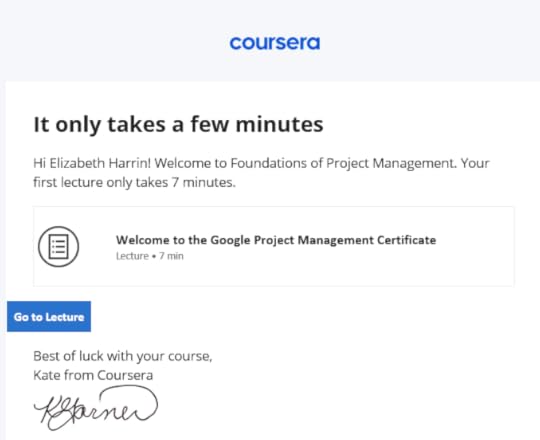 Welcome email from Coursera – they email you regularly to keep you on trackSet up of the course
Welcome email from Coursera – they email you regularly to keep you on trackSet up of the courseBasically, if you do the work in the certificate program, you’ll pass. There is a lot of work to do. It’s not a quick-win course to get the certificate, and even if you breeze through the Foundations module like I did, it will still require you to do a lot of learning to earn the certificate.
I’m not sure if the course is available in other languages, but I signed up to it in English. The course materials include:
Training videos – you can control the playback speed, hurrah!‘What it’s like to be a PM’ videos – these are quick chats from project and program managers working at Google talking about their role and career journeyTranscripts – these sit under the videos and the relevant text is highlighted as the speaker talksReading materials – sometimes these are a PDF to download, other times it’s content to read on the screenDiscussion forums – if you want to take part in the discussion forums and connect with other students, you can.The video lectures aren’t really lectures at all. They are short, interesting, very high quality and well-structured. The presenters are clear and obviously experienced.
I liked that the examples used are real-world scenarios and reflective of the kind of projects that you would be managing in an actual entry-level project management role.
I have used a few different learning management systems for online training courses and the Coursera platform that this certificate uses is really slick. The video pops out when you scroll down the page. The notes capture tool is great – little touches like that make it easy to use and minimizes the effort you have to expend on training.
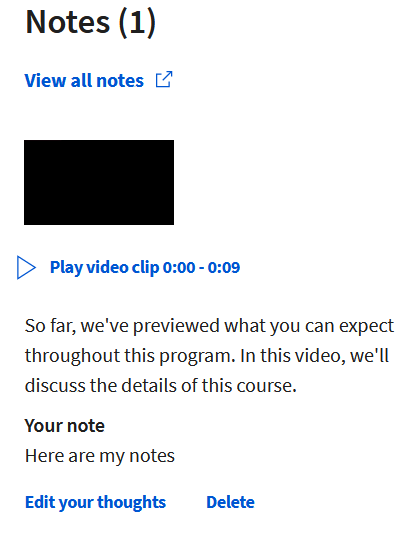 The notes feature in the Coursera platformHow long does the Google Project Management Certificate take?
The notes feature in the Coursera platformHow long does the Google Project Management Certificate take?The recommendation is 10 hours of study per week, and that will mean you complete all the content in 6 months.
I took the first course in a lot less than 10 hours, but it is the Foundations course, and I consider myself to be a bit beyond Foundations level in my career. If you are new to the content, it could take you that long.
Assessments and passingEach module includes in-video check point quizzes, which I quite liked because they help you recap the important points in the training.
As well as those, there are also practice quizzes that help you prepare for the end of module graded quiz. There are other exercises to do as well, such as reflection exercises. You have to score 100% on those but I reckon as long as you enter text in the boxes you would pass – they are not graded and they are designed to support your personal learning.
The assumption is that you will take about 1 month per course, which is 1 week per module. Overall, that’s 6 months to work through the materials.
I think you can do it much faster if you dedicate time to it, but it is going to depend on how much project management experience you have. If you are completely new to the topics, you will want to spend more time digesting the course content.
As I have worked in project management for quite a few years now, I found some of the Foundations module, for example, very straightforward, and I was able to get through that course quickly.
The exact amount of time you’ll have to spend is going to depend on how much time you can dedicate to studying, and how quickly you pick up the concepts.
Taking the graded quizzesEach module ends with a timed, graded quiz. Coursera is clear that it has to be your own work, so there are pop ups that require you to commit to the honor code and promise that it’s all your own work.
However, you can have other windows open on your computer as you do the quiz, and there is more than enough time to go through the quiz, answer the questions that you can do from memory, and then review the relevant course materials and go back and answer the questions.
In essence, each quiz is an open book exam.
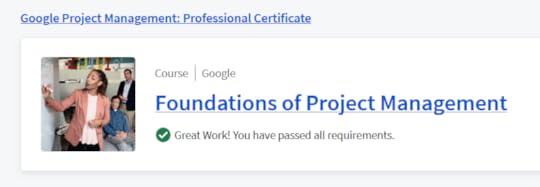 Yey! I completed the course. Five more to go!Peer-graded assessments
Yey! I completed the course. Five more to go!Peer-graded assessmentsMuch of the certificate relies on graded quizzes, but some of the courses and the Capstone project include peer-graded assignments.
This is where you submit your work and your peers review it. You also have to review other people’s work, and if you don’t, that could affect your overall grade. It’s (in theory) a great way to encourage participation and it helps you learn how to write effective project documentation.
There are thousands of students doing the course so don’t worry that no one will be available to review your work.
I’ll be honest: I haven’t finished the Capstone yet, but I looked at the process and I have to create a project charter as a Google doc amongst other things, based on a scenario they provide (so I can’t simply upload one I’ve already created for another project). At least with everyone working on the same scenario, the person who reviews will have some idea of what it is supposed to say.
What you need to pass the courseTo pass the course, you need time. Beyond that, you just need a decent internet connection and a notebook to jot down your notes, although the platform does have a note feature built in.
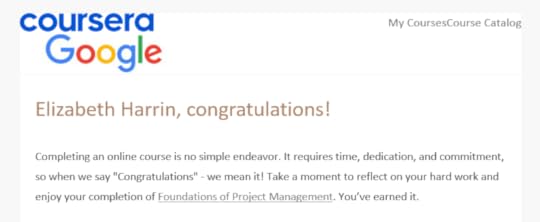 You get an email when you complete the course, and you can share your achievement online too.Pros
You get an email when you complete the course, and you can share your achievement online too.ProsThe advantages of the Google Project Management certificate are:
It’s good value. There is a lot of content covered.You don’t need any prior experience.You work through scenarios and case studies in the course, including in the Capstone, so you get to put your skills into practice (even though it’s not a ‘real’ project).The course is definitely good quality.The videos remember the speed settings you have set so you can keep watching the next videos at the pace you’ve chosen.To earn the certificate, all you have to do is complete all the work.That final point sounds easy, but trust me, there is a lot of content to get through for the certificate, so don’t underestimate the amount of work and learning involved, especially if you are coming to the topics completely new.
There is no certification exam, but there are peer-reviewed assignments. So if you are nervous about taking exams, that’s another reason to take this course. As long as you put the time and effort in, you can get through it!
The discussion forums are active and the materials are engaging so you can keep yourself motivated. I didn’t use the discussion forums but I like knowing that they are there.
ConsThe disadvantages that I found are as follows.
It’s very hard to find out how much the Google Project Management certification course costs. You have to sign up for an account first, and then Coursera pushes you into a free 7-day trial. After that it’s £32 per month, or the equivalent in your country.
There is no price per course, it is a subscription model (Coursera Plus) based on how long it takes you to work through the materials.
Tip: Before you sign up, make sure you have enough time to spend on the training, as the faster you complete it, the less you end up paying on the monthly subscription.
Peer-graded assignments. You have to wait 7-10 days for someone to assess your submitted assignments, so if you are hoping to get through all the materials super-fast, you are unable to get your final certificate awarded until all your peer assignments are graded.
I thought this would be a big problem as I had allocated time to work on the course, but in hindsight I don’t think it will cause too many issues. However, I wonder if it would be better to have an instructor review. I understand that with the volume of people doing the courses that would be hard.
It’s also a little Google-y and maybe a little US-centric (I couldn’t find any UK universities in the drop down list when setting up my profile). But whatever, it’s a very solid course overall.
Recommendation: Should you buy this course?If you are seriously considering a career in project management and want a certificate to put on your job applications from a training firm that people will recognize, then the Google project management certificate is a fantastic entry-level certificate.
Get a subscription, book a week off work and just do it all, as much as you can in that time.
Or, pace yourself more sensibly than I did and commit to working on the study materials over the 6 months that Google recommends it takes you to work through the materials.
Ready to check it out yourself?
Recommended Google Project Management Certificate 5.0
Google Project Management Certificate 5.0 A solid, professional, well-recognized project management course from a great training provider. Perfect for beginners and people interested in learning more about project management as a career.
Learn more We earn a commission if you click this link and make a purchase, at no additional cost to you #adI should let you know that I am impressed with the course and that I’m now an affiliate for the Coursera platform so I can recommend it, but I only recommend products I have tested out and am confident in.
This article first appeared at Rebel's Guide to Project Management
March 7, 2023
PM Illustrated – The Fun Site to Support Your PMP® Exam Studies
This is a guest post by Mike Griffiths.

“Fun” and “PMP Exam” are rarely used in the same sentence. Too often, training materials are text-based, process-focused, and dry.
However, fun is a serious business in adult learning; it boosts retention and cuts study time. We recall facts about our favorite hobbies and sports teams much easier than boring information because our brains prioritize fun experiences for recall. This is why great trainers who can make a topic enjoyable are so valuable.
Visual learning
The other secret weapon in slashing our study time is Visual Learning. Research into visual thinking by David Hyerle, reports that 90% of the information entering the brain is visual. 40% of all nerve fibers connected to the brain are connected to the retina, and a full 20% of the entire cerebral cortex is dedicated to vision – so let’s use it.
Using a combination of cartoons, images, mind maps, and explanations, we can engage our brain’s right and left hemispheres to build stronger comprehension and better recall.
Tests show most people only remember 10% of what they heard three days ago. Add an image to the message, and this figure jumps to 65%.
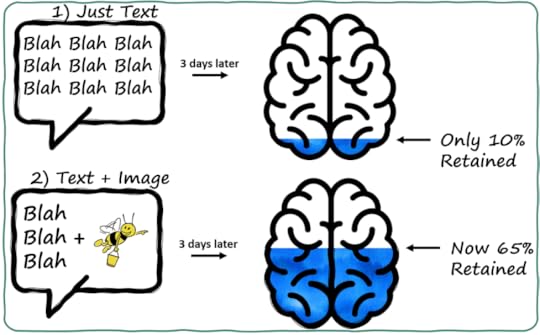 But why animal cartoons?
But why animal cartoons?Because they are cute, funny, and memorable. The memorable part is valuable for exam preparation. Images that are surprising for the context, such as using animals to show project management topics, are “stickier” in our brains.
In the book “Made to Stick“, authors Chip and Dan Heath explain we remember things that are simple, unexpected, and emotional.
Animal cartoons about project management do all three.

(Here, we see the herd welcoming zebra, who is a bit different, but it is all good.)
Our brains are lazy and filter out the ordinary or familiar. Recall vacations; the first few days are often memorable because everything is new and different. Then the last few days seem to pass quickly in a blur. Our brain skips the familiar stuff, presumably saving space for valuable fresh information.
To help us study for exams more effectively, we can trick our brains into marking everything as new, unusual, and needing to be stored away by associating it with the unfamiliar.

(Be the bridge to success for others)
The good news is you will find recall much easier. The bad news is you might try and thank a snake instead of avoiding it.
Chock full of games for PMP skill testingTest your application and recall of critical topics through a wide variety of fun games. There are word games (crosswords, word search), sorting games (process steps, hierarchies), and quiz show games.
There are also badges to earn and collect to track your progress, with points and optional leaderboards if you want to gamify your studies.
See the big picture – Navigate the scope of the PMP Exam via three different roadmapsChart your own adventure – travel through the topics in any order you chooseGamification – Track your progress by earning digital badges with voluntary leaderboardsSelf Assessment – Check your understanding at the end of each module with quiz questionsHere’s the link: PM Illustrated – A Visual Learner’s Guide to Project Management – while it works on mobile, it works best on desktop devices.
Managing projects is anything but dull; studying how to do it should not be dull, either.
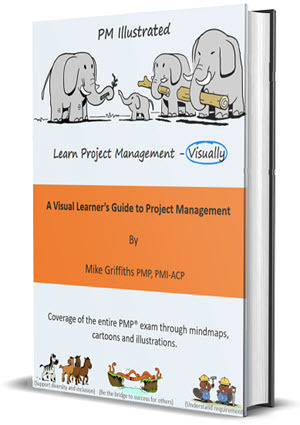 PM Illustrated is also available in book format
PM Illustrated is also available in book formatBuy it as a hardback, paperback or get the Kindle version on Amazon.
This article first appeared at Rebel's Guide to Project Management
March 6, 2023
Business Resilience: An Overview
Business Resilience: A practical guide to sustained progress delivered at pace is a book by an impressive authoring team.
The tone is set immediately with the powerful introduction: this is not a book for the faint-hearted! To get the benefits of better business resilience, you need to commit at the most senior levels within the delivery and change organization, preferably at board level.
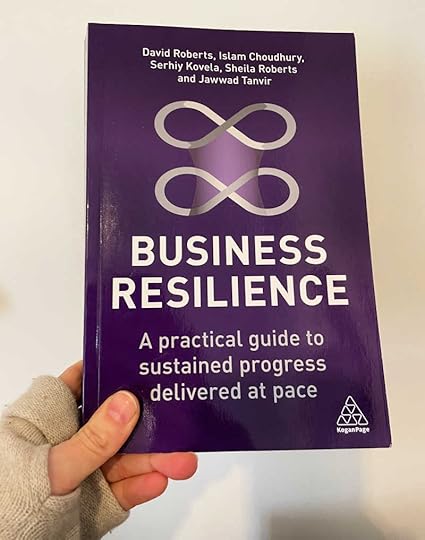 This is my copy, gifted to me by the authors. I’m wearing Turtle Dove wrist warmers as it is so cold in my office!What is business resilience?
This is my copy, gifted to me by the authors. I’m wearing Turtle Dove wrist warmers as it is so cold in my office!What is business resilience?Business resilience is the ability for an organization to benefit from disruption and deliver at pace even in times of instability. It’s about future-proofing your business so you can adapt quickly, pivot when needed and keep morale high even when the situation is changing rapidly.
There are 5 domains in the business resilience framework laid out in the book.
book5 domains for business resiliencePrinciples: The 7 principles that should be in place to ensure ownership for this approach (more on these below)
Roles: The core responsibilities for ownership, implementation and action.
Foundations: The elements that create the building blocks for success, summarized by the acronym RESILIENCE (handy).
Culture: The groundwork to create psychological safety, summarized by the acronym PACE.
Cycle: The roadmap for development and improvement over time, summarized by the acronym PROGRESS.
There are a lot of parts to the resilience framework laid out in the book, and on my first skim through, I was confused by the different acronyms and how it all fits together. There are some useful diagrams, but be prepared to unpick the different layers of the model and map these into your own corporate jargon as required.
I would keep the diagrams in front of you as you read so you can quickly refer back to where you are in the framework. There are also useful tables to help you see how different sections relate to each other.
The principles of business resilienceThe 7 principles of business resilience are:
Business resilience is essential for organizational survival.Change is certain; business resilience and progress are not.Strong focus on customer value enhances business resilience.Ensuring diverse thinking builds business resilience.Ethical practice builds long-term business resilience.Business resilience and progress can be realized at a fast or slow pace.Adopting a robust model focused on progress strengthens business resilience.These are all pretty obvious statements. I mean, you wouldn’t put them in front of an exec and expect them to disagree. However, I think having them laid out clearly adds some weight to what you are doing if you are moving towards improving resilience in your business environment and changing the company culture.
The benefits of business resilienceSo if the principles are what you’d expect senior leaders to be focused on anyway, what are the benefits of adopting a specific approach to resilience. Why should we use a framework to hold our resilient organization together?
The benefits are laid out in the book and they are clear. Disruptive events can be critical moments for businesses. Basically, organizations that can’t adapt in difficult times die out. And you don’t want that for your business.
Resilient businesses are able to harness change and make the most of disruptive forces. They still make progress (in the right direction, at the right pace) regardless of what is happening around them in the socio-economic climate. If you want your firm to be in business in 100 years, you’d better bake resilience into how it operates at every level.
Some other less obvious but equally important benefits are:
Increasing productivityAdopting a ‘one team’ approach across the organizationDelivering in a predictable fashion (every PMO leader wants this!)Improving customer satisfaction and retentionReducing costs and reworkRetaining key staff and talent at all levelsIncreasing competitive advantage and taking more market share.Setting the sceneThe first sections of the book describe the whole framework and the benefits of business resilience. There is guidance on the roles required to make it a success.
My key takeaway from this section was that you need buy in at the most senior levels. In an organization that does not plan strategically, and is relatively short-sighted, this approach is not going to be a success.
Unsurprisingly, those are the organizations where resilience and future-proofing against economic shifts is probably not high on the agenda anyway — are those leadership teams really focused on long-term value?
Who is this book for?This book would be great for PMO practitioners. It’s a different take on implementing strategy and would feed into a PMO mission statement.
If you are a project practitioner in a delivery role, it is still an interesting and useful read, but it doesn’t necessarily align to the way you do projects now. The book definitely aligns with modern project management practice and thinking, but it goes wider than that too.
You’d need a fair degree of influence to be able to shift the thinking in the PMO or department to build in resilient business processes, but some of it you could definitely do like:
Using focus groupsConsidering sustainability in project solutionsCarrying out competitive analysis as part of pre-project business case work (if you get involved with that)Focusing on customer valueUnderstanding what ‘progress’ looks like for the project and how that links back to the portfolioReviewing your practice at regular intervals.None of these items individually would be any surprise to people working in projects today, but put together in a strategic way I can see how you can shift the focus on delivery to something that is geared up to be flexible and adaptive.
Putting it into practiceOne of the best things about the book is that it does help you put the skills into practice. Being a resilient organization means more than simply having business continuity plans or being prepared for natural disasters. It’s a new way of thinking about business models and how you deliver change over time.
There are self-assessment scales so you can rank your performance currently and identify gaps. There are inputs and outputs diagrams so you can see exactly what to do to implement each of the activities.
The chapter on tools for business resilience is useful too, as it talks about the specific tools you can use, their purpose and how to use them.
Throughout the book you will also find case studies and boxes with stories in, as well as the voices from the front-line section towards the end for more real-life examples. I found the stories interesting, and I wasn’t surprised to see Blockbuster in there! Equally, there are lots of references to the Covid-19 pandemic and the impact of coronavirus on businesses.
Tailoring the frameworkTowards the end of the book is a chapter on adapting the operational resilience framework to your own organization. This is very “on trend” with project management thinking at the moment: all the professional bodies and certification schemes seem to be hot on tailoring approaches, and this is no different. Still, it’s useful to see adaptation approaches called out so specifically.
You can adapt and tailor every part of the framework apart from the values, which underpin everything and really can’t be changed.
Key takeawaysMy key takeaways from the book are these.
It’s a huge job to set this framework up. There are many moving parts, lots of sub-bullet point items and pieces that have to come together to do it all ‘properly’. You have to take a strategic approach across the entire organization.
The good news is that you don’t have to do it all. You can choose to work towards increasing resilience and pick the tools, principles, approaches you want to do.
A successful implementation requires top level executive support from business leaders as it could involve rethinking the whole strategy and delivery approaches across every aspect of the business. That’s a big job. But don’t be put off by the scale of it all. Think about the pieces you already have in place and what could be added easily, and then put together plans to work on the rest.
Long after you’ve retired, your customers and staff will be grateful that you put the effort in.
Buy now on Amazon.
This article first appeared at Rebel's Guide to Project Management



